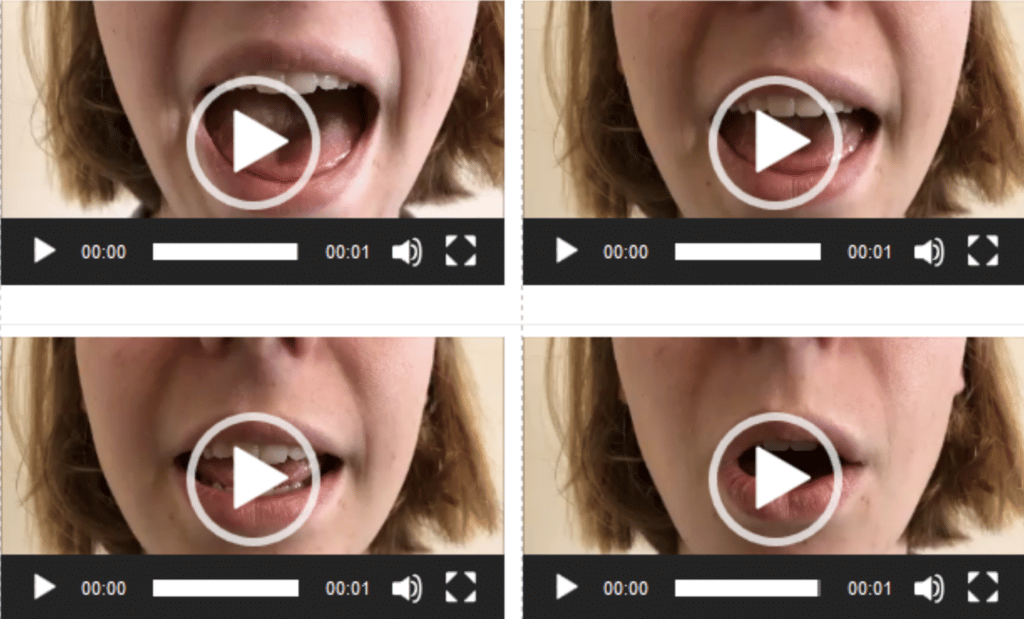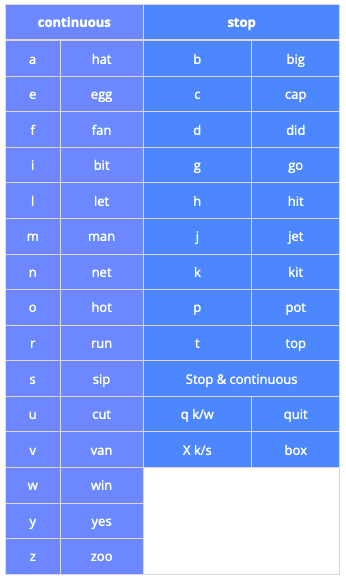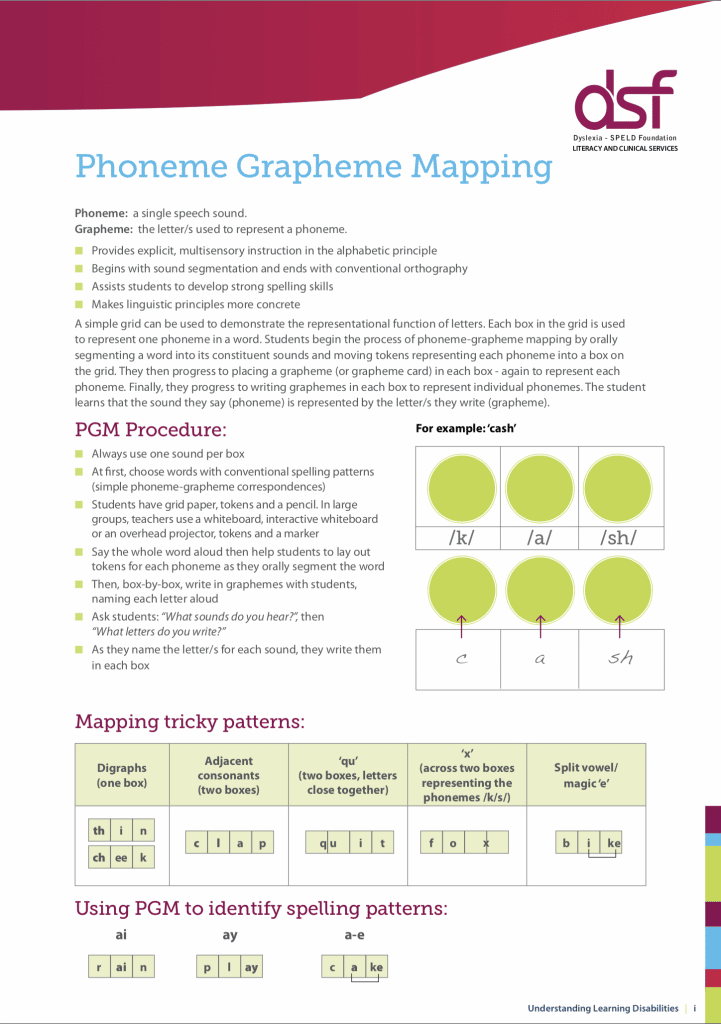Teaching grapheme-phoneme correspondences
Home » Phonics » Essential principles of systematic and explicit phonics instruction » Teaching grapheme-phoneme correspondences
Written English is a code for speech. Spoken English has approximately 44 speech sounds that combine to make thousands of words but we only have 26 letters with which to represent them in writing.
The individual speech sounds that make up words are called phonemes. The individual letters or groups of letters that represent the individual speech sounds are called graphemes. Understanding how graphemes map to phonemes is essential for learning to read or ‘decode’ words efficiently.
Phonemes and graphemes
Teaching systematically
When teaching grapheme-phoneme correspondences it is imperative to take a systematic approach. A systematic approach starts with a clearly planned sequence of phonic elements that builds gradually from simple to complex. Attention is paid to the teaching process, checking for student understanding, ensuring active and successful participation of all students, and allowing time for practice of newly learned knowledge and skills.
Beginning students will require multiple exposures to letters and their corresponding names and sounds before they become rapidly and automatically recalled. Students who have difficulty with phonological processing will need careful monitoring because they will take longer to develop this knowledge.
Explicit beginning instruction – 5 vowel sounds
Explicit beginning instruction – warm up with digraphs
Correct pronunciation of phonemes is critical
Beginning readers acquire letter sound knowledge by matching their visual memory (letters) with their phonological memory (sounds). All beginning readers need to know how to produce speech sounds (phonemes) in isolation, and how to pronounce these phonemes correctly. It is important for teachers to carefully articulate the phonemes of speech in order to facilitate the critical phonemic awareness skills of blending and segmenting.
Teachers need to be aware of stop sounds and continuants, as well as voiced and unvoiced phonemes. Stop sounds are those that are said for a very short time because the airflow is stopped completely for a short time. Continuous sounds are sounds that can be held for several seconds without distortion. Stop sounds are more difficult for students to sound out than continuous sounds.
Common mistakes teachers make include distorting a sound or adding an additional ‘schwa’ or vowel sound to unvoiced consonants such as pronouncing /p/ as “puh”, which should be said as though you are puffing out a candle. Articulating an additional sound makes it more difficult for a student to blend together or synthesise individual sounds to say or read a word. Explicitly teaching voiced and unvoiced phonemes facilitates reading and spelling acquisition and should not be underestimated.
To demonstrate the importance of this for yourself, put your fingers on your throat and switch between saying the sounds “sssssss” and “zzzzzzz”: you will feel the vibration in your throat as your voice box turns on and off, yet your mouth stays in the same position. When writing these sounds, they are represented by two different graphemes. This multisensory technique can be used to help students correctly articulate the voiced and unvoiced phonemes.
Speech pathologist Alison Clarke from Spelfabet has made this series of videos demonstrating voiced and unvoiced phonemes and more.
Kilpatrick (2016) outlines a number of well-established methods for teaching GPCs
- Provide multiple exposures
- Use multisensory methods of learning (tracing and writing letters while saying their phonemes)
- Teach small set of letters at a time
- Teach letter sounds in a developmentally appropriate manner
- Point out visual features of letters
- Teach letter sounds using embedded mnemonic letters
Kilpatrick, D. (2016). Equipped for reading success. Casey and Kirsch.
Letter names or letter sounds first?
Knowing letter names gives beginning learners some clue as to the sound that the grapheme will make when written in a simple word. Consider the letters B, D, J, K, P, T, V, Z . Their letter names all contain a clue to the sound the individual grapheme makes in a word — B (b-ee), D (d-ee), J (j-ay). These letters are often easier to learn than the letters that have clues at the end of their names — F (e-ff),L (e-ll), M (e-m), N (e-n), R (ar), S (e-ss), X (e-ks).
Some common vowel digraphs can be pronounced the same way as the letter names children may already know, e.g. /ai/ & /ay/ = A, /ee/ = E .
The hardest letters to learn are those that have less obvious clues in their names such as H, U, Y, and W. Learners who have difficulty learning letter names and/or learning to link phonemes with graphemes often have weak phonemic awareness skills. There are also some graphemes that represent two speech sounds — ‘x’ which is the speech sounds k/s together, and qu that is made up of k/w.
Letters and Sounds – Phase 2 materials (page 50) has examples of how to teach children to say a discrete phoneme, as well as recognise and write the letter that represents that phoneme.
Useful tips for helping to solve b & d confusion from Love and Reilly (2014)
Overcoming letter confusion
Lower case b and d are commonly confused because they are similar in visual and auditory properties. It is important to teach them to mastery, with some children requiring more practice than others. Cognitive neuroscientist Stanislas Dehaene explains that our brain’s ‘neuronal networks are destined to visual object recognition’. Our ability to recognise objects that are mirror reversed is inherited from evolution. When we are very young we learn that the spoken word ‘chair’ still applies to a chair no matter which way we see it, but we have to learn not to apply this to letters, because they have different names and auditory properties according to their rotation and position in a word.


Overcoming b and d confusion can be quite tricky, however there are evidence-based strategies that can be used, including writing practice.
Teaching children to form the letters correctly while they articulate the corresponding phoneme is a very powerful process. Again Dehaene’s (2019) work is useful in explaining that in a young readers brain, ‘a collaboration must take place between the ventral visual pathway, which recognises the identity of letters and words, and the dorsal pathway, which codes for their location in space and programs eye movements and attention. When any of these actors stumbles, reading falls flat on its face’ . Therefore, multisensory methods incorporating writing with phonological and visual training are more effective than just phonological and visual training alone; this idea has been demonstrated in research by Bara & Gentaz (2011).
Overcoming b and d confusion is best achieved by looking at the letters and writing them whilst linking them to their corresponding phonemes. In the initial stages a simple memory hook may prove useful to get the correct letter direction and formation, for example, d becomes “round in a circle up and down” and b becomes “down, halfway up and around” or, “b is a back and a belly”. Essentially, we must allow plenty of time for practice. Practice makes permanent and builds automaticity, which reduces the cognitive load that handwriting places on the reading and spelling process and frees up working memory for other tasks.
Mapping exercises
A useful tool for demonstrating to early readers the function of graphemes and their relationship to phonemes is a phoneme-grapheme mapping exercise (see Figure 1 below). This type of activity is valuable because it
- Provides explicit, multi-sensory instruction in the alphabetic principle
- Begins with sound segmentation and ends with conventional orthography
- Assists students to develop strong spelling skills
- Makes linguistic principles more concrete
A simple grid helps to demonstrate the relationship between phonemes in a spoken word and corresponding letters or graphemes. Each box in the grid represents one phoneme.
Firstly the oral word needs to be segmented into its constituent phonemes and, initially, one token is moved into a box for each phoneme. Once students are able to segment the phonemes they can then progress to placing a grapheme into the box in place of the token. Magnetic letters or letter tiles are useful for this type of exercise. Finally, students progress to writing the grapheme in the box to represent the individual phoneme. This helps the student to understand the relationship between the sounds in a word and the grapheme choices used to spell the word.
Before students can attempt a direct mapping exercise like this they must have the ability to orally segment a word and have some knowledge of letter-sounds. An essential part of this process is the anchoring of the graphemes to the phoneme sequence in the spoken word, for example recognising the difference between ‘pot’ and ‘top’.
Figure 2 demonstrates the multiple spelling choices for the long a phoneme and can help students understand spelling patterns. Students would not be presented with all of these spellings in one activity. It merely represents an example of how phonemes and graphemes may be isolated and mapped.
These exercises are cognitive scaffolding for beginning and struggling readers as they learn the relationship between sound and print.
Students will not need to use mapping activities for every word they read in order for it to be recognised quickly and effortlessly. With systematic and explicit instruction in the patterns of English orthography and the opportunity to practice with carefully selected decodable texts, students will eventually be able to perform this task mentally.





